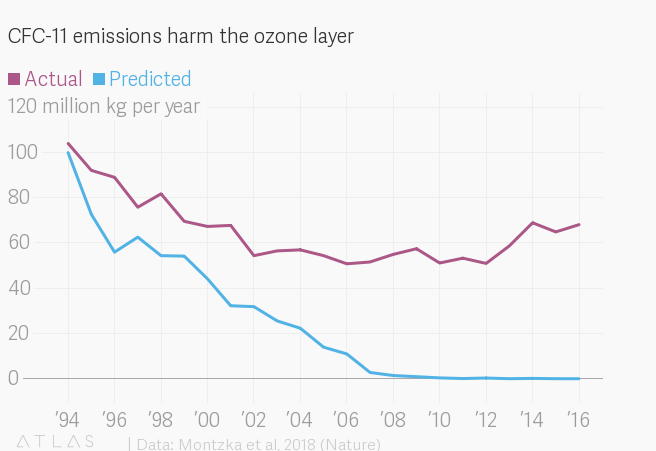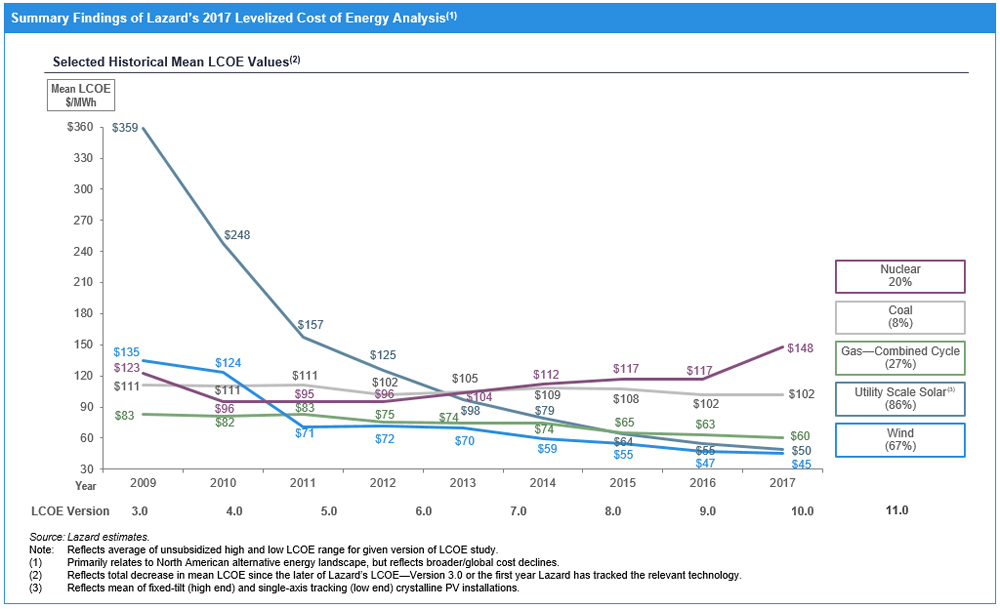
China is the world’s largest emitter of greenhouse gasses so we should be particularly interested in the level of its emissions, as well as the success of the practices and policies it pursues to reduce them. After all, China’s emissions are likely to have the greatest influence on future global warming and our ability to keep average global temperature rise to less than 2°C above those of the pre-industrial era.
However, CO2 emissions in 2017 for China are not known with any accuracy, even by the Chinese government. Some estimates suggest 9.8 gigatonnes (Gt.), while others claim it to be 11.7 Gt. Clearly both can not be right and it is possible that both estimates could be wrong.
The 1987 Montreal Protocol has been signed by China and 197 other countries. The Protocol commits all countries to abolish production and use of ozone depleting halocarbon gasses to zero by 2010 because they destroy the ozone layer which protects the earths surface from harmful ultra violet radiation. Halocarbons are also very powerful greenhouse gasses, particularly CFC-11 which has a lifetime in the atmosphere of 45 years or more
The Kigali Amendment (2016) further requires phase-down of all hydrofluorocarbon gasses which have a greenhouse effect, some of which can be used as a substitute for halocarbons.
If all countries had complied with the Montreal Protocol, it should have been expected that global CFC-11 emissions would have fallen sharply after 1995 when developed countries were required to reduce their production and use and to zero by 2010 when all other countries ceased production. However, as show in Fig. 1, this is not what has happened.

Fig. 1. Decline in CFC-11 emissions predicted by the 1987 Montreal Protocol compared with actual emissions recorded by NOAA. Source: Montzka et al., 2018.
On the basis of air samples taken in South Korea, NOAA’s Dr Montzka concluded that the likely source of CFC-11 emissions was in east Asia, even though all countries in that region reported to the UN administering authority that they remained in compliance with the Montreal Protocol.
Apart from being an ozone destroyer, CFC-11 is also a very potent greenhouse gas with Global Warming Potential 4,750 times that of CO2. Measurement of CFC-11 concentration in the atmosphere show that around 67,000 tonnes of CFC-11, or 0.3 Gt CO2eq. are reaching the atmosphere each year from these sources. The Chinese Government has not previously been ‘officially’ aware of these and possibly other emissions when compiling statistics on greenhouse gas emissions.
In 2017 a London based organisation, the Environmental Investigation Agency (EIA) determined that China was the source of these emissions. In 2018 the EIA published its report ‘Blowing It’ which concluded that at least 18 Chemical Companies in 10 Provinces are actively engaged in the production of CFC-11 and that it is used throughout China as a blowing agent for production of insulating foam products used in the building and other industries. The reason for its on-going use? It was easier to use and more profitable than use of alternative gasses.
The production and use of CFC-11 in China could be more widespread than reported by EIA. Even if this is not the case, it is difficult to understand how such widespread production and use of CFC-11 could have gone undetected by the Chinese National and ten Provincial Governments for so many years. How could the EIA investigate and compile a detailed report on the matter in less than a year while the UN agency responsible for ensuring international compliance with the Montreal Protocol has yet to offer comment or action?
In a well researched article, Tiboku Hirochi points to the dichotomy of huge investment made by China in renewable energy (prompted by the need for breathable air in megacities) and the building of large numbers of coal fired power stations, many of them overseas. She reports findings from the Urgewald data base which concludes that companies specialising in design and construction of coal-fired power stations are engaged in or propose building 1,600 new power stations in 62 countries. Eleven of the 20 largest companies involved in their construction are either owned or financed by the Chinese Government.
It is estimated that if all of these coal-fired power stations were built, they would have the capacity to increase global coal-fired electricity generation by 43%, significantly increasing greenhouse gas emissions at a time when the IPCC is calling for their rapid reduction. Chinese companies are engaged in designing, building and in some cases owning and operating coal fired power stations in developing countries. Many of these investments are part of the One Belt – One Road expansionist initiative of the Chinese Government. Further, over the last 15 years some $50 billion has been invested by China in the production, transport and use of coal.
It appears to be State Policy to promote increased use of coal both within China and by investment overseas. Some of the countries where coal-fired power stations are being built by Chinese companies (eg Malawi, Egypt, Pakistan, Iran and others) will be using coal-fired electricity generation for the first time. Rather than speeding-up transition to a decarbonised economy, those building additional coal fired generating capacity are collectively slowing the process and, in so doing, committing the world to average global warming well in excess of 2°C by 2100 and a climate which will be both unpredictable and dangerous.
Developing countries intending to host new fossil-fuelled electricity generation need to understand – but may not fully do so – that they are committing themselves, possibly until 2060, to using energy which, as shown in Fig. 2, is already more expensive than electricity generated from renewable sources. If the latter were unable to ensure production of dispatchable power 24/7 this might be understandable but this is no longer the case. Advances in technology now enable grid scale renewable generators to store electricity as pumped hydro or in batteries, the latter already available at a cost of less than $4/MWh and falling further as storage capacity continues to rise.

Fig. 2. The levalized cost of generating electricity in North America from renewable sources fell; below $50/mWh in 2017, lower than Gas ($60/mWh) and other non-renewable sources. The cost of generating from renewables is likely to continue falling. Source: Lazards LCOE 11.
The implications for economic development are that countries reliant on expensive new coal fired generation will find it difficult to produce goods and services for export or domestic use at the same price as countries now converting to much cheaper renewable energy. They may be able to compensate for reliance on more expensive energy by lowering the cost of other factors of production, such as the cost of labour but this could result in lower living standards and more expensive good and services.
A more serious aspect of continued expansion and reliance on coal fired generation is that it adds carbon dioxide to the atmosphere, increasing the speed with which global warming occurs. Unless the intended increase in use of coal is stopped, it could result in average global warming of more than 2°C above pre-industrial temperatures, possibly as soon as 2050 and over 3°C by 2100. The result could be catastrophic onset of:
There is only one way we can avoid the worst effects of these outcomes and that is by reducing greenhouse gas emission and doing so as rapidly as possible. The most effective way of achieving this is to reduce burning fossil fuels and meeting energy needs from renewable sources. This is being achieved by Australian State Governments which have approved investment in renewable energy on a scale predicted to result in the country meeting 50% of national electricity demand from renewable sources before 2030. If Australia can achieve this outcome, so can Egypt and other African countries now seeking to build coal-fired power stations.
Reports that work on building ‘hundreds’ of coal-fired power stations has resumed in China is reported to be associated with a decision of the Central Government to delegate policy implementation and environmental monitoring to Provincial governments. The result is generating capacity which, for the time being, far exceeds demand but does keep the workforce fully employed and so contributes to maintaining national stability (Fn). It also caters for future growth enabling closure of older, dirtier power stations. This may be so but more centralised administration, ensuring prompt closure of high emitting generators seems desirable if real reduction in emissions is to be achieved. There is no evidence that such closures are occurring.
Can China and others engaged in proliferation of fossil-fuelled power stations be persuaded to offer host countries renewable energy instead? China is, after all, a major producer and exporter of solar panels and wind turbines so a change to funding overseas renewable electricity generation would stimulate this sector of their domestic economy, produce new employment opportunities and create new wealth.
Should multilateral funding agencies such as the I.B.R.D. or UN agencies such as the UN Environmental Program be more closely monitoring countries intending to expand use of coal to generate electricity or for other industrial uses? Could multilateral banks offer them finance on concessional conditions to build renewable generating capacity with appropriate storage to ensure continuity and stability of supply? Could such finance match or better offers made by China and other countries now funding new fossil fuelled power generation?
It may no longer be possible to avoid a more severe climate or the destructive effects of sea level rise later this century but their onset can – and must - be slowed so that technology and strategies can be developed to deal with the effects of their inevitable onset. Pursuing the status quo is not an option unless we wish to risk the need to deal with the effect of a more severe climate which irreparably damages world food production and transport infrastructure in coming decades.
Footnote: A frequent visitor to China reminded me that the country had always been ruled by dynasties which remained in power for as long as they held the ‘Mandate of Heaven’. The Communist Dynasty which presently ruled would do so as long as it could maintain very high employment levels but were that ability to fail, the Dynasty would fall. The imperative of maintaining high employment may account for the building of ‘ghost cities’ containing 64 million vacant apartments, unused infrastructure - and power stations surplus to demand – all paid for by public debt of such magnitude as to endanger, rather than strengthen, national stability.
Posted by Riduna on Wednesday, 31 October, 2018
 |
The Skeptical Science website by Skeptical Science is licensed under a Creative Commons Attribution 3.0 Unported License. |